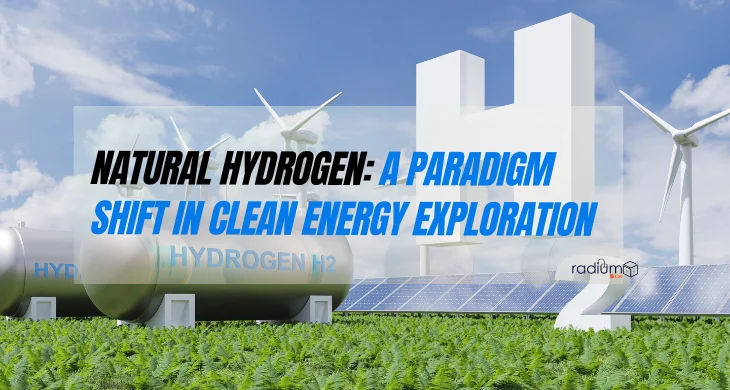As the world grapples with the dual challenges of a growing population and escalating climate change impacts, the quest for sustainable energy alternatives has become increasingly urgent. Against this backdrop, the discovery of natural hydrogen has ignited considerable excitement and hope within the scientific community and beyond. This article delves into the intriguing concept of natural hydrogen, its pivotal role in transitioning to cleaner energy sources, and the profound implications it holds for shaping the future of sustainable energy. By examining the potential of natural hydrogen as a viable energy solution, we aim to shed light on its significance in addressing pressing environmental concerns and fostering a more sustainable energy landscape for generations to come.
Understanding Natural Hydrogen
Natural hydrogen is a remarkable phenomenon where pure hydrogen gas is naturally emitted from the earth’s crust, similar to how crude oil or methane is found. This discovery was first made in Mali, where the gas was unexpectedly found seeping from the ground, sparking interest and research into its properties and potential applications. Unlike hydrogen produced through industrial processes, natural hydrogen occurs organically, making it a fascinating subject of study for scientists and researchers. Its purity and abundance have led to speculation about its viability as a clean and potent energy source, particularly in the context of the global transition towards sustainable energy solutions.
The discovery of natural hydrogen in Mali prompted further exploration worldwide, with researchers identifying similar occurrences in various regions, including Switzerland, France, and the United States. These findings have led to the establishment of numerous companies dedicated to locating and extracting natural hydrogen, highlighting the growing interest and investment in this emerging energy resource.
Natural hydrogen seeps are not confined to land; they have also been identified on the seafloor and continents, further expanding the potential scope of exploration and utilization. Examples of natural hydrogen occurrences in places like Turkey, the Philippines, and Greece demonstrate the diverse geological conditions under which this gas can form.
As research into natural hydrogen continues to advance, there is growing optimism about its role in the global energy landscape. With its potential to provide a clean and sustainable alternative to traditional energy sources, natural hydrogen holds promise for addressing the world’s growing energy needs while mitigating environmental impact.
The Rise of Natural Hydrogen
The commercialization of natural hydrogen in Mali marked a significant turning point in the energy sector, sparking widespread interest and investment in the exploration of subsurface natural hydrogen resources worldwide. This groundbreaking development prompted researchers and companies to redirect their efforts towards identifying and harnessing natural hydrogen deposits hidden beneath the Earth’s surface.
As governments and private entities recognize the potential of natural hydrogen as a clean and sustainable energy source, significant investments have been allocated to support research, development, and extraction initiatives. This increased funding has accelerated exploration efforts, leading to the identification of natural hydrogen reservoirs in various regions across the globe.
The shift in focus towards natural hydrogen reflects a growing awareness of the need to transition towards cleaner and more environmentally friendly energy sources. With concerns about climate change and carbon emissions mounting, there is a pressing need to reduce reliance on fossil fuels and embrace renewable alternatives.
Natural hydrogen offers a compelling solution to this challenge, providing a clean and abundant energy source that can help mitigate the environmental impact of traditional energy production methods. By tapping into natural hydrogen reserves, countries can reduce their carbon footprint and move towards a more sustainable energy future.
The growing momentum behind natural hydrogen exploration underscores its potential to revolutionize the energy landscape and drive positive environmental change. As research and development efforts continue to progress, natural hydrogen is poised to emerge as a key player in the global transition towards a more sustainable and resilient energy system.
Global Exploration and Potential
Across diverse landscapes, from the arid deserts of Mali to the rugged mountains of Switzerland, geologists have uncovered a treasure trove of naturally occurring hydrogen sources. These hydrogen seeps, distinguished by their unique geological formations and chemical compositions, have captivated the imagination of scientists and entrepreneurs worldwide. This fascination has spurred the emergence of numerous dedicated companies and research endeavours, all aiming to unlock the vast potential of this abundant energy resource.
From remote regions where active exploration projects are underway to sophisticated laboratory settings where cutting-edge research is conducted, efforts to harness natural hydrogen are progressing on multiple fronts. The collaborative spirit among scientists, engineers, and investors underscores the immense significance of this endeavour in shaping the future of energy production and sustainability.
With each new discovery and technological advancement, the horizons for natural hydrogen continue to broaden, offering promising prospects for a cleaner and more sustainable energy future. The exploration and utilization of natural hydrogen represent not only a scientific and technological challenge but also a beacon of hope for addressing pressing environmental concerns and transitioning towards greener energy solutions. As researchers push the boundaries of innovation and exploration, the potential of natural hydrogen to revolutionize the global energy landscape becomes increasingly apparent, paving the way for a brighter and more sustainable future to come for generations.
Harnessing the Potential
As scientists delve deeper into the exploration of natural hydrogen, the promise of harnessing this abundant resource grows ever brighter. With ongoing advancements in technology and innovative exploration techniques, the potential to tap into natural hydrogen’s vast reserves becomes increasingly tangible. This natural gas, seeping from the earth’s crust, holds the key to transforming the energy landscape by providing a clean and sustainable alternative to conventional fuel sources.
As researchers push the boundaries of scientific understanding and engineering prowess, the vision of a future powered by natural hydrogen comes into sharper focus. From remote deserts to underwater seafloors, efforts to uncover and utilize natural hydrogen are expanding, driven by a shared commitment to environmental stewardship and energy sustainability.
With each breakthrough and discovery, the pathway to a cleaner, greener energy future becomes clearer, offering hope for a world powered by nature’s own resources. As we stand on the cusp of a new era in energy innovation, the potential of natural hydrogen to revolutionize the way we power our world cannot be overstated.
By harnessing the power of natural processes and renewable resources, we have the opportunity to create a more sustainable and resilient energy system for future generations. With determination and collaboration, we can unlock the full potential of natural hydrogen and pave the way for a brighter and more sustainable future.
Conclusion
As the world seeks cleaner and more sustainable energy solutions, the exploration and development of natural hydrogen reserves offer a ray of hope for a greener future. With continued research and investment, natural hydrogen has the potential to reshape the global energy landscape and drive the transition towards a more sustainable future.
Frequently Asked Questions
Que: What is natural hydrogen?
Ans: Natural hydrogen refers to pure hydrogen gas that naturally seeps from the earth’s crust, similar to crude oil or methane.
Que: Where are natural hydrogen sources found?
Ans: Natural hydrogen sources have been identified globally, including in Mali, Switzerland, France, the United States, Turkey, and the Philippines.
Que: How is natural hydrogen produced?
Ans: Natural hydrogen is produced through processes such as serpentinization of ultramafic or ophiolitic complexes and the electrolysis of groundwater in uranium-containing rocks.
Que: What are the potential applications of natural hydrogen?
Ans: Natural hydrogen has potential applications in decarbonizing industrial processes, transportation, heating, and electricity generation.




